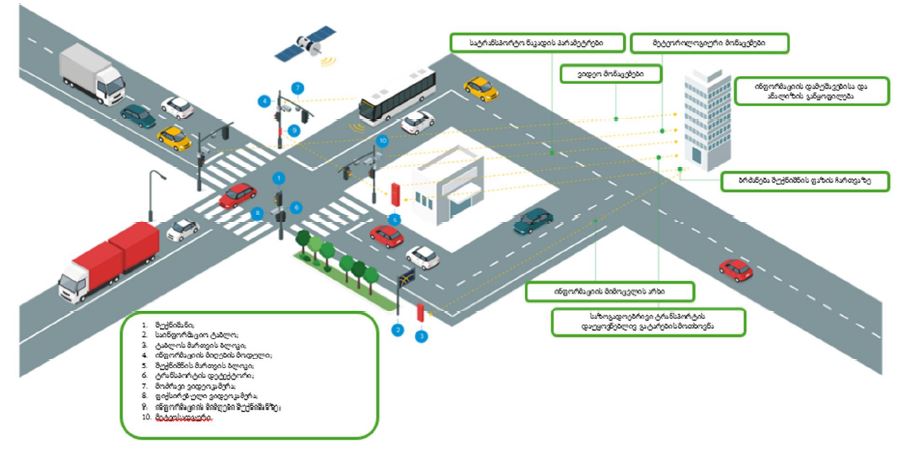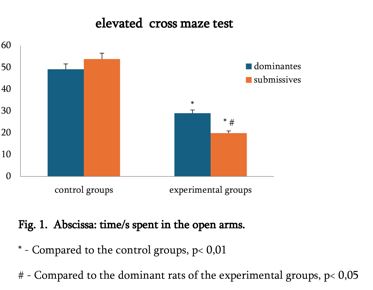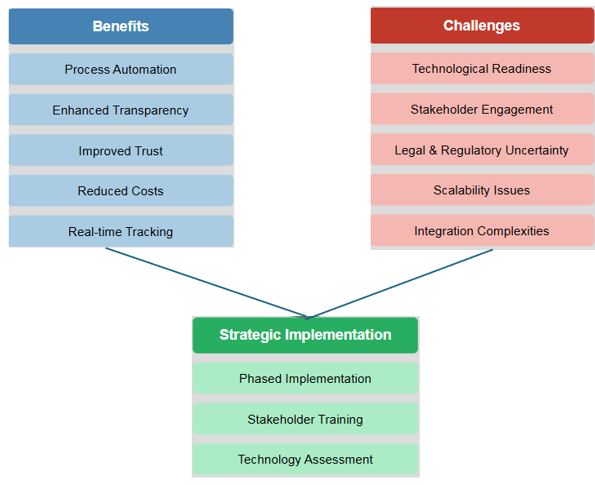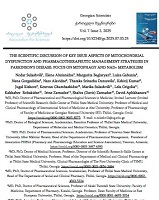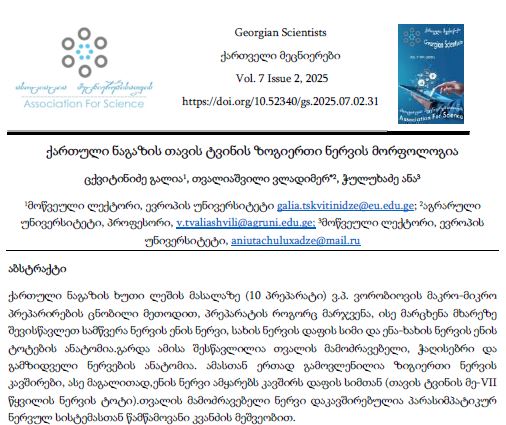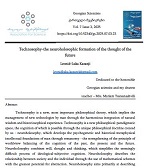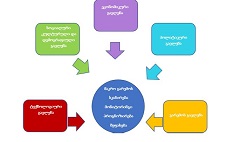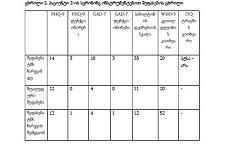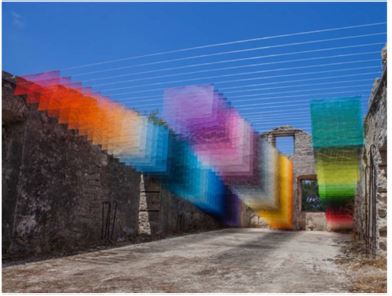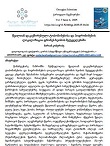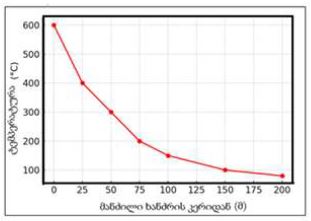ლიმფოციტური დუოდენიტების ჰისტოლოგიური და იმუნოჰისტოქიმიური პროფილი და ადგილობრივი იმუნური რეაქციების თავისებურებები
ჩამოტვირთვები
ლიმფოციტური ენტერიტები ხასიათდება ინტრაეპითელური ლიმფოციტების პათოლოგიური ინფილტრაციით ნაწლავის ლორწოვან გარსში. ის მოიხსენიებოდა, როგორც თორმეტგოჯა ნაწლავის ლიმფოციტოზი, ან ლიმფოციტური დუოდენიტი. დღესდღეობით კი ეს ტერმინი მოიცავს გლუტენით გაშუალებული, ან მის გარეშე განვითარებული დაავადებების საერთო მახასიათებლებს. ლიმფოციტური ენტერიტის ყველაზე ხშირი მიზეზებია Helicobacter pylori ინფექცია, მედიკამენტებით გამოწვეული დაზიანება და გლუტენთან დაკავშირებული დარღვევები, როგორიცაა ცელიაკია და არა-ცელიაკიური გლუტენ-მგრძნობელობა. ნაკლებად ხშირად, ლიმფოციტური ენტერიტები შეიძლება გამოწვეული იყოს ზოგიერთი აუტოიმუნური მდგომარეობით, იმუნოგლობულინის დეფიციტით, ბაქტერიული და ვირუსული ინფექციებითა და გაღიზიანებული ნაწლავის სინდრომით. შესაბამისად, ლიმფოციტური ენტერიტების დიაგნოსტიკა წარმოადგენს მნიშვნელოვან პრობლემურ საკითხს.
Downloads
G. Caio et al., “Celiac disease: a comprehensive current review.,” BMC Med, vol. 17, no. 1, p. 142, Jul. 2019, doi: 10.1186/s12916-019-1380-z.
S. Husby, J. A. Murray, and D. A. Katzka, “AGA Clinical Practice Update on Diagnosis and Monitoring of Celiac Disease-Changing Utility of Serology and Histologic Measures: Expert Review.,” Gastroenterology, vol. 156, no. 4, pp. 885–889, Mar. 2019, doi: 10.1053/j.gastro.2018.12.010.
J. A. Silvester, A. Therrien, and C. P. Kelly, “Celiac Disease: Fallacies and Facts.,” Am J Gastroenterol, vol. 116, no. 6, pp. 1148–1155, Jun. 2021, doi: 10.14309/ajg.0000000000001218.
V. Villanacci et al., “Celiac disease: histology-differential diagnosis-complications. A practical approach.,” Pathologica, vol. 112, no. 3, pp. 186–196, Sep. 2020, doi: 10.32074/1591-951X-157.
V. Villanacci et al., “Celiac disease: histology-differential diagnosis-complications. A practical approach.,” Pathologica, vol. 112, no. 3, pp. 186–196, Sep. 2020, doi: 10.32074/1591-951X-157.
R. Del Sordo et al., “Histological Features of Celiac-Disease-like Conditions Related to Immune Checkpoint Inhibitors Therapy: A Signal to Keep in Mind for Pathologists.,” Diagnostics (Basel), vol. 12, no. 2, Feb. 2022, doi: 10.3390/diagnostics12020395.
R. Dieli-Crimi, M. C. Cénit, and C. Núñez, “The genetics of celiac disease: A comprehensive review of clinical implications.,” J Autoimmun, vol. 64, pp. 26–41, Nov. 2015, doi: 10.1016/j.jaut.2015.07.003.
A. K. Akobeng, P. Singh, M. Kumar, and S. Al Khodor, “Role of the gut microbiota in the pathogenesis of coeliac disease and potential therapeutic implications.,” Eur J Nutr, vol. 59, no. 8, pp. 3369–3390, Dec. 2020, doi: 10.1007/s00394-020-02324-y.
J. A. Tye-Din, H. J. Galipeau, and D. Agardh, “Celiac Disease: A Review of Current Concepts in Pathogenesis, Prevention, and Novel Therapies.,” Front Pediatr, vol. 6, p. 350, 2018, doi: 10.3389/fped.2018.00350.
G. Caio et al., “Celiac disease: a comprehensive current review.,” BMC Med, vol. 17, no. 1, p. 142, Jul. 2019, doi: 10.1186/s12916-019-1380-z.
E. M. Quinn et al., “Transcriptome Analysis of CD4+ T Cells in Coeliac Disease Reveals Imprint of BACH2 and IFNγ Regulation.,” PLoS One, vol. 10, no. 10, p. e0140049, 2015, doi: 10.1371/journal.pone.0140049.
R. Celli et al., “Clinical Insignficance of Monoclonal T-Cell Populations and Duodenal Intraepithelial T-Cell Phenotypes in Celiac and Nonceliac Patients.,” Am J Surg Pathol, vol. 43, no. 2, pp. 151–160, Feb. 2019, doi: 10.1097/PAS.0000000000001172.
Y. Sahin, “Celiac disease in children: A review of the literature.,” World J Clin Pediatr, vol. 10, no. 4, pp. 53–71, Jul. 2021, doi: 10.5409/wjcp.v10.i4.53.
P. Laurikka, L. Kivelä, K. Kurppa, and K. Kaukinen, “Review article: Systemic consequences of coeliac disease.,” Aliment Pharmacol Ther, vol. 56 Suppl 1, no. Suppl 1, pp. S64–S72, Jul. 2022, doi: 10.1111/apt.16912.
S. Hussein et al., “Clonal T cell receptor gene rearrangements in coeliac disease: implications for diagnosing refractory coeliac disease.,” J Clin Pathol, vol. 71, no. 9, pp. 825–831, Sep. 2018, doi: 10.1136/jclinpath-2018-205023.
A. Lerner, M. Arleevskaya, A. Schmiedl, and T. Matthias, “Microbes and Viruses Are Bugging the Gut in Celiac Disease. Are They Friends or Foes?,” Front Microbiol, vol. 8, p. 1392, 2017, doi: 10.3389/fmicb.2017.01392.
G. Caio, G. Riegler, M. Patturelli, A. Facchiano, L. DE Magistris, and A. Sapone, “Pathophysiology of non-celiac gluten sensitivity: where are we now?,” Minerva Gastroenterol Dietol, vol. 63, no. 1, pp. 16–21, Mar. 2017, doi: 10.23736/S1121-421X.16.02346-1.
V. F. Zevallos et al., “Nutritional Wheat Amylase-Trypsin Inhibitors Promote Intestinal Inflammation via Activation of Myeloid Cells.,” Gastroenterology, vol. 152, no. 5, pp. 1100-1113.e12, Apr. 2017, doi: 10.1053/j.gastro.2016.12.006.
G. Losurdo et al., “Small intestinal bacterial overgrowth and celiac disease: A systematic review with pooled-data analysis.,” Neurogastroenterology and motility, vol. 29, no. 6, Jun. 2017, doi: 10.1111/nmo.13028.
M. Rostami-Nejad et al., “Pathological and Clinical Correlation between Celiac Disease and Helicobacter Pylori Infection; a Review of Controversial Reports.,” Middle East J Dig Dis, vol. 8, no. 2, pp. 85–92, Apr. 2016, doi: 10.15171/mejdd.2016.12.
A. K. Kamboj and A. S. Oxentenko, “Clinical and Histologic Mimickers of Celiac Disease.,” Clin Transl Gastroenterol, vol. 8, no. 8, p. e114, Aug. 2017, doi: 10.1038/ctg.2017.41.
D. C. Baumgart and C. Le Berre, “Newer Biologic and Small-Molecule Therapies for Inflammatory Bowel Disease.,” N Engl J Med, vol. 385, no. 14, pp. 1302–1315, Sep. 2021, doi: 10.1056/NEJMra1907607.
E. Ierardi et al., “Lymphocytic duodenitis or microscopic enteritis and gluten-related conditions: what needs to be explored?,” Ann Gastroenterol, vol. 30, no. 4, pp. 380–392, 2017, doi: 10.20524/aog.2017.0165.
საავტორო უფლებები (c) 2023 ქართველი მეცნიერები

ეს ნამუშევარი ლიცენზირებულია Creative Commons Attribution-NonCommercial-NoDerivatives 4.0 საერთაშორისო ლიცენზიით .
































